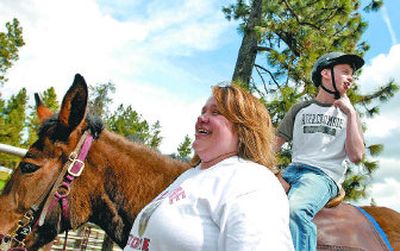Mules a lesson in genetics

Creating the world’s first cloned mule was hardly a simple process, but one of the University of Idaho scientists behind the effort, Dirk Vanderwall, is well-practiced in providing clear explanations for complicated questions.
He wasn’t much help, though, to the seventh-grader who asked: Do clones have souls?
It’s an important question, Vanderwall said, but one for ethicists or religion scholars.
That sort of discussion was exactly what Cathy Richards was hoping for. She teaches life science to seventh-graders at Northwest Christian Schools, in Colbert, and helped arrange the field trip Friday to a farm near Rathdrum where the first cloned mule, Idaho Gem, spends much of his time.
Richards thought the visit would be a good way for students to gain a new perspective on genetics and the ethics of cloning.
“This will definitely stir conversation at home tonight,” Richards said, as her students took turns riding noncloned mules on Don Jacklin’s farm.
Richards doesn’t believe humans should be cloned, and she doesn’t support the use of human embryos for stem cell research. Before visiting the farm Friday and talking with Vanderwall, she was also uneasy about cloning other creatures, including mules. Now, she’s not so sure.
“I’m probably more confused now than when I started out,” Richards said. “Would I support it if I had cancer, and they could use a couple of rats and sheep to help get rid of it? Well, yeah!”
Fighting cancer is precisely why scientists at the University of Idaho and Utah State wanted to clone a member of the horse family. Vanderwall and his colleague Gordon Woods – who recently took a job at Colorado State University – cloned the animals four years ago to help identify how calcium levels are regulated in cells. Calcium plays a role in certain cancers and adult-onset illnesses, including diabetes.
The scientists also wanted to understand why horses are three times less likely than humans to be afflicted with cancer.
Although Vanderwall didn’t try to answer the tough ethical questions about cloning, he hoped to help the students understand that the mules might have been created in a lab, but they’re not Frankenmules. Apart from being clones of a champion racing mule, Idaho Gem, Idaho Star and Utah Pioneer look and act like any other mule.
Government funding for cloning and stem cell research is now being debated by politicians. Vanderwall thinks such research has huge potential for medical therapies, but he didn’t ask the students to take a position on the issue.
“With any new technology, there are questions,” he said. “Important decisions are now being made. … It’s important for everyone to weigh in.”
The three cloned mules weren’t at the farm Friday – they’re in training for the coming racing season. Last year, Gem and Star competed on the Nevada-California circuit. Star’s season ended early because of shin splints, but Gem was ranked second-fastest among three-year-olds. They will race again beginning in June.
The mules are leased by Don Jacklin, of Jacklin Seed fame, who is president of the American Mule Racing Association. Jacklin, who was the main private sponsor of the cloning project, has a granddaughter attending Northwest Christian Schools.
Students from the school said cloning no longer seems like science fiction – “I used to think they used a machine you walked into and it copied you,” said 13-year-old Carmen Whitley – but that doesn’t mean Friday’s field trip made it all clear.
“It’s hard to follow,” said Catherine Penaskovic, 13. “It’s hard to understand how they clone, but I know they do it.”
“I understand it a little more, but not a lot,” said Seth Miller, 13. “It’s weird.”
Richards, their teacher, said there will be time later to talk about it. The field trip wasn’t just about learning – it was also a chance for the young men and women to blow off some springtime steam running through Jacklin’s grassy fields on a sunny April morning.
“They’re seventh-graders,” Richards said. “They’ll play, we’ll all have fun, then go back and talk about it.”